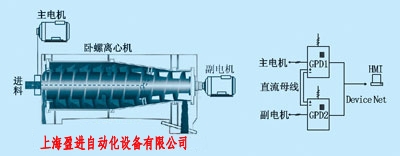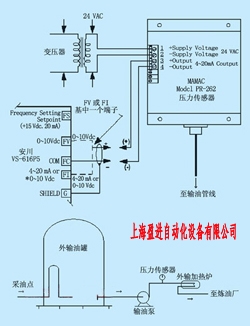Yaskawa inverter application in the oil industry
Over the years, Yaskawa has accumulated a wealth of experience in the oil industry. For example, various series of inverters such as g7/p7/f7/g5/p5/g5hhp/vs have been widely used in OEMs. There are centrifuges, pumps, fans, transportation equipment, metering equipment, compressors and so on.
Yaskawa inverters used in the petrochemical industry have the following features:
(1) Its nema 3r package can withstand the common harsh environment of the oil field;
(2) Its special custom driver software case can work very effectively on reciprocating loads such as boring machines, eliminating the need for powerful dynamic braking resistors;
(3) Its excellent hardware design and pc board spraying process make the inverter work normally in the fields of oilfield and other harsh environments and high vibration rate.

Yaskawa Inverter Decanter Centrifuge Application:
The load that the main motor drags is the cylinder body, and the load that the auxiliary motor drags is spiral, because in the normal operation, the speed of the main motor is always higher than that of the auxiliary motor, which causes the auxiliary motor to work in the power generation state for a long time. The traditional method is to use energy. Severe eddy current braking, which is equivalent to poor braking system speed. Obviously, it is very significant to fully utilize this part of energy.
Yaskawa's plan is based on the common connection of the inverter bus bars, and the energy of the auxiliary motor is consumed by the bus between the two inverters to the main motor's electric state, so that the energy is shared between the inverters through the bus, thus greatly improving the system. The stability and reliability, while reducing energy consumption, compared to the traditional eddy current brake energy saving of 20% to 40%. Yaskawa's gpd
The 515/g5 uses a vector mode of operation. By installing an encoder, differential speed control can be accurately achieved, and at the same time, sufficient torque can be provided even when the material is clogged.
The control system of decanters using Yaskawa's variable frequency control mainly has the following features:
(1) The human-machine interface hmi (usually a pc-based system) is used as the host to control, including the devivenet communication between inverters, the bus voltage monitoring, reading and writing of the parameters of each inverter, and the control of feed points;
(2) The main motor adopts gpd 515g5 inverter to control the operation of the cylinder. Because it operates under the vector control mode, it can provide enough starting torque to overcome the cylinder's inertia and start smoothly;
(3) The auxiliary motor also uses gpd
515g5 to control the spiral to run below the speed of the main motor, the speed difference between the screw and the drum can be automatically adjusted according to the changes in the feed, in the case of congestion, the screw can provide enough torque to push the material out, empty and Run again;
(4) Regeneration energy processing through common busbars. The amount of regenerative energy depends on the rotational speed of the cylinder and the difference between the rotational speed of the cylinder and the spiral;
(5) The coating design of the inverter circuit board with the explosion-proof motor can make the system work stably in the harsh environment of the oil field, such as water vapor, corrosive gas, unexpected vibration and so on.
Through the application of multiple oil fields worldwide, decanters equipped with Yaskawa's gpd series inverters have achieved remarkable results. The output of crude oil dehydration in the oil field is increased ten-fold. Because the centrifuge can operate without failure for a long time, the inverter can easily overcome the material change and can be freely adjusted and output.
Because frequency conversion speed regulation is energy-saving, environment-friendly and easy to adjust, it can solve the problems of energy consumption and heating of eddy current brakes and leakage problems caused by hydraulic drive. Parts of transmission can be replaced by standard parts, so decanter centrifuges can be maintenance-free. The application of the fieldbus devicenet makes it easy to set up and monitor the drive. The user can get all the drive operation data and set the corresponding process data on the hmi. To achieve the pressure of the pumping station, the pid control pipeline is to transfer the crude oil (or oil) from a place (usually an oil field) to another place (usually a refinery, a dock, etc.) by heating and heating through an oil pipeline. The purpose of the pressurization is to provide kinetic energy for crude oil to overcome the geographical location along the line and the pressure loss along the pipeline;
Yaskawa Inverter Application in Oil Pumps
In the original control scheme, the pressure pump station achieved simple pressure control through a programmable controller, that is, when the pressure reached the low limit, the pump was turned on and when the pressure reached the high limit, the pump was turned off. Frequent start-stop actions will have a powerful impact on the power grid for heavy-duty motors, as well as certain damage to crude oil pipelines. Due to the simple on/off control, the pressure of oil delivery is unstable and the pressure fluctuates, which causes certain difficulties for the process control of crude oil gathering and transportation system.
At the same time, the frequency of frequent maintenance of the valve parts, pipelines and other maintenance caused by the growing, there will be a serious tank evacuation, pipeline plugging and crude oil tanking accidents, resulting in a lot of waste production. In order to solve these contradictions, the introduction of variable frequency speed control technology in the existing crude oil gathering and transmission network, automatic tracking and adjustment of the operating state has received good results.

In the pressurized pumping station, after the original main pump is driven by Yaskawa's inverter, it can conveniently use the integrated pid function inside the inverter to perform pressure closed-loop control. The pressure sensor signal installed at the user's pipe end directly enters the fv or fi terminal of the inverter. The inverter will automatically calculate the difference between the set value and the inverter output.
After the inverter is used, the pump station not only significantly reduces the mechanical loss and maintenance, but also greatly reduces the impact on the power grid. It reduced the rated current of the motor from 600% to 800% to about 150% from the original direct start. It also rose to about 98%. Due to the PID control, the motor speed is no longer at full speed and idling, but the speed is reduced and the average operating current is reduced from more than 160a to about 116a (about 30% lower).
Due to potential high pressure problems in oil pipelines, users have to install pressure sensors that are more than 10 times the normal pressure standard.
The effective voltage range of the sampled voltage is very narrow. Only the high-precision pressure sensor is selected for normal PID control. At the same time, the drive of the frequency converter must be effectively tuned to tune the parameters, so that the motor and the pump work in the best condition. In order to avoid the pipeline resonance effect, it is also necessary to set the mechanical resonance point.
In the oil industry, water injection is often performed. The main method is to use injection wells to inject water into the reservoir, and the measures to supplement and maintain the reservoir pressure are called water injection. After the oilfield is put into development, as the mining time increases, the reservoir itself will continue to be depleted of energy, resulting in continuous pressure drop in the reservoir, a large number of underground crude oil degassing, viscosity increase, well production is greatly reduced, or even stop spraying, resulting in underground A large amount of dead oil cannot be recovered. Therefore, in order to compensate for the underground deficit caused by crude oil production, maintain or increase the pressure in the reservoir, achieve high and stable production of the oil field, and obtain a high recovery rate, water injection must be performed on the oil field.
In the pump configuration of many oilfield water injection stations, the power is very large, usually using industrial frequency step-down starting, and most of the centrifugal pumps are used to control the flow through the throttle valve. We know that the use of a frequency converter in a centrifugal pump has a very large potential for energy saving, so in the case of adequate pump design margins, the use of variable frequency speed control is an optimal solution. Using Yaskawa f7, you can easily achieve energy-saving operation and suppress higher harmonics. In the energy-saving control operation range of f7, it is controlled according to the maximum efficiency, and it can exert superior energy-saving effects on centrifugal pumps.
WARNING!
Do not plug two or more meters together!
IMPORTANT
Don't plug in an appliance where the load exceeds 16 Amp. Always ensure the plug of any appliance is fully inserted into the meter outlet. If cleaning of the meter is required, remove from mains power and wipe meter with a dry cloth.
KEYBOARD DEFINITION
1). SET: Set price with button UP.
2). MODE: Exchange display state.
3). UP: Set price combined with button SET.
GENERAL FEATURES
1).Display line power.
2).Display and memory accumulative total power quantity.
3).Display and memory total power charge of price.
THE DATA DISPLAY
Press MODE button the data displays as follows:
W →KWh →PRICE →COST/KWH
↑_ _ _ _ _ _ _ _ _ _ _ _ _ _ _ _↓
1). Plug in socket and power on, the meter will display real power.
2). Press MODE button once again and release, the meter will display accumulative KWh.
3). Press MODE button once again and release, the meter will display total power charge.
4). Press MODE button once again and release, the meter will display COST/KWH.
SETTING PRICE OF COST/KWH
1). Press SET button during display COST/KWH,the first digital COST/KWH flash, press UP button to set it.
2). Press SET button once again and release, the second digital COST/KWH flash, press UP button to set it.
3). Press SET button once again and release, the third COST/KWH flash, press UP button to set it.
4). Press SET button once again and release, the fourth COST/KWH flash, press UP button to set it.
5). Press SET button once again and release, the radix point COST/KWH flash, press UP button to set it.
DATA CLEAR
Press and hold MODE button for 5 seconds will clear KWH,PRICE and COST/KWH data.
Power Meter Plug Energy Monitor,Backlight Power Metering Socket,Blue Backlight Power Meter Socket,Multi-functional Backlight Power Meter Socket
NINGBO COWELL ELECTRONICS & TECHNOLOGY CO., LTD , https://www.cowellsockets.com